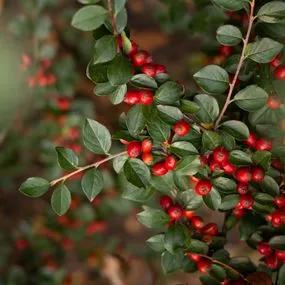Himalayan Cotoneaster Hedge Plants
The details
Himalayan Cotoneaster
Hedge Plants- Late season red berries.
- Semi-evergreen.
- Hedging & screening
- Max Height: 2-3m
- Bareroot Delivery: Nov-March
Recommended extras
Description
Cotoneaster simonsii Hedging
Delivered by Mail Order Direct from our Nursery with a Year Guarantee
Himalayan Cotoneaster is a strong growing, upright, semi-evergreen shrub that clips neatly as a hedging plant. Cotoneaster simonsii is almost evergreen; it keeps its leaves in a mild winter and loses them, usually in late winter, if the weather is harsh. This is normal and doesn't hurt the plants.
Its small, dense leaves make it ideal for hedging and it responds well to regular clipping if you want to keep it really neat. It has lots of charming, tiny flowers in spring and bright red berries in autumn and early winter. Cotoneaster simonsii is good for hedges up to about 2 metres high. It is often planted in a mixed hedge with the Orange Berried Cotoneaster franchetii for a bit more colour.
Browse all of our other varieties of Cotoneaster shrubs & trees. Alternatively, see our selection of coastal hedging or view our full range of hedging plants.
Bareroot hedge plants are delivered bareroot during winter (Nov-Apr) and are measured by their height in centimetres above the ground (the roots aren't measured).
Planting Instructions
Growing Cotoneaster simonsii plants:
Cotoneaster is happy in most soils, including chalk, and it doesn't mind a bit of shade. It likes a heavy clay soil, as long as it is not prone to waterlogging in winter. It will grow near to the coast, as long as the soil is fertile.
Prepare your site before planting:
It is good to dig over the area where you plant a hedge several months in advance, especially if the soil is poor. Destroy the weeds first: nettles, brambles and ground elder are tough. Then dig the soil over; remove rocks, roots and other rubbish. Mix in well rotted compost or manure down to the depth of about 2 spades. If your soil is rich, you don't have to dig it over, but killing all the weeds is still necessary.
Watch our video on how to plant a garden hedge for full details. The plants in this video are delivered pot-grown, but planting out bareroot stock is essentially the same.
Remember to water establishing plants during dry weather for at least a year after planting.
Hedge Planting Accessories:
Prepare your site for planting by killing the weeds and grass.
You can buy a hedge planting pack with sheets of mulch fabric and pegs to hold it down.
If you are planting in an area with rabbit and/or deer, you will need to use a plastic spiral guard for each plant, supported by a bamboo cane.
If your soil quality is poor, we recommend using mycorrhizal "friendly fungi" on the roots of new trees and shrubs.
After Care
After you have planted your Cotoneaster simonsii hedge, the most important thing to do is water it in dry weather. You will also need to weed around the plants. Watering should be thorough, so the ground is soaked. Let the soil almost dry out before watering again. Watering & weeding will be necessary for at least a year after planting.
Trimming Formal hedge plants:
Cotoneaster simonsii is naturally bushy, so it doesn't need any clipping at all in its first year. In the winter of the year after planting, your young hedge should be trimmed once, lightly, and then every winter after that until it is mature.
When it is fully grown, you can clip it at anytime. A good time to trim your hedge is after the berries fall or lose their appeal in winter.
Special notes on caring for Cotoneaster simonsii hedges:
Cotoneaster simonsii is a tough hedge plant that shouldn't need special attention once it has established. If you didn't use a mulch fabric, it is beneficial to mulch around the base of the hedge each year.
Hygiene & Diseases:
Dead, damaged or diseased wood can be pruned off as soon as it appears.
Disinfect your pruning tools between every cut if there is any sign of disease.
Burn or dispose of any diseased material, do not compost it.
After you have planted your Cotoneaster simonsii hedge, the most important thing to do is water it in dry weather. You will also need to weed around the plants. Watering should be thorough, so the ground is soaked. Let the soil almost dry out before watering again. Watering & weeding will be necessary for at least a year after planting.
Trimming Formal hedge plants:
Cotoneaster simonsii is naturally bushy, so it doesn't need any clipping at all in its first year. In the winter of the year after planting, your young hedge should be trimmed once, lightly, and then every winter after that until it is mature.
When it is fully grown, you can clip it at anytime. A good time to trim your hedge is after the berries fall or lose their appeal in winter.
Special notes on caring for Cotoneaster simonsii hedges:
Cotoneaster simonsii is a tough hedge plant that shouldn't need special attention once it has established. If you didn't use a mulch fabric, it is beneficial to mulch around the base of the hedge each year.
Hygiene & Diseases:
Dead, damaged or diseased wood can be pruned off as soon as it appears.
Disinfect your pruning tools between every cut if there is any sign of disease.
Burn or dispose of any diseased material, do not compost it.
Did You Know?
Cotoneaster simonsii comes from the Himalayas and was brought to Britain in 1865.


